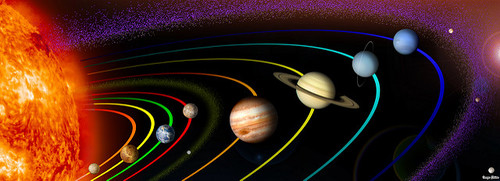12.9 连接:我们绕太阳旅行
章节大纲
-
Today it is common knowledge that the Earth, as well as the other planets in the solar system, orbits the sun. But just 500 years ago, scientists, philosophers, and astronomers were arguing that the Earth was the center of the solar system, and all other celestial bodies orbit the Earth. During the European Renaissance (roughly the 1300s to the 1600s), some of the greatest scientists of the time began to question the Earth-in-the-center model. One of these men, Nicolaus Copernicus, determined that the Earth revolved around the sun. Copernicus believed this orbit to be circular.
::今天,众所周知,地球以及太阳系中的其他行星环绕着太阳运行。但就在500年前,科学家、哲学家和天文学家们就认为地球是太阳系的中心,而所有其他天体则环绕地球。在欧洲复兴时期(大约是1300到1600年代 ) , 当时最伟大的科学家开始质疑地球在中枢模型。 这些人之一 — — 尼古拉斯·科白尼科(Nicolaus Copernicus) — — 确定地球围绕太阳旋转。 哥白尼相信这一轨道是环绕的。Another scientist, Tycho Brahe, who worked as the royal astronomer to the king of Denmark, found that Copernicus's theory did not match his data. Brahe obsessively charted the positions of every visible heavenly body, w hile most astronomers of his time collected only a few measurements. Like many men of his time, he believed that the Earth, not the sun, was the center of the universe. If the planets, and especially the Earth, traveled in circles around the sun, they would be in different positions than the ones in which he observed them.
::另一个科学家,丹麦国王的皇家天文学家Tycho Brahe(Tycho Brahe)曾任丹麦国王的皇家天文学家,他发现哥白尼的理论与他的数据不符。Brahe执着地绘制了每个可见的天体的位置图,而他时代的大多数天文学家只收集了几点测量数据。和他时代的许多人一样,他相信地球,而不是太阳,是宇宙的中心。如果行星,特别是地球绕着太阳环绕着太阳环绕,那么它们的位置将不同于他所观察的物体。In 1602, the astronomer Johannes Kepler was working on a problem for his boss, Tycho Brahe. Kepler was continuing a centuries-old study, trying to devise a formula that could calculate the orbits of the planets, specifically Mars, in this case. He worked for years on the problem with the most advanced technology of the time, but was never satisfied with the results, as they were never truly accurate or reliable.
::1602年,天文学家约翰尼斯·开普勒(Johannes Kepler)为他的上司蒂乔·布拉赫(Tycho Brahe)解决了一个问题。 开普勒(Kepler)正在继续一项历时数百年的研究,试图设计出一种计算行星轨道的公式,特别是火星轨道。 多年来,他一直在研究当时最先进技术的问题,但从未对结果感到满意,因为这些结果从来不是真正准确或可靠的。In 1605, Kepler finally had the answer. After Brahe's death, Kepler discovered that his boss was partially right: The Earth did not travel around the sun in a circle. Kepler realized that the planets' orbits were ellipses, not circles. The sun was at one focus, and the Earth and all the other planets traveled around it. Once Kepler published his theory with the mathematics to back it up, the heliocentric model of the universe began to gain acceptance. His discovery would firmly place him as one of the most famous scientists of all time 1 .
::1605年,开普勒终于找到了答案。布赖赫死后,开普勒发现他的上司部分是对的:地球没有绕太阳环绕一个圆圈。开普勒意识到行星的轨道是椭圆,而不是圆圈。太阳是一个焦点,地球和所有其他行星环绕着它。开普勒发表了他的理论和数学支持它后,宇宙的日光中心模型开始得到接受。他的发现将使他成为有史以来最著名的科学家之一。1Let's consider three planets: Mercury, which is closest to the sun, Earth, and Neptune, which is farthest from the sun.
::让我们考虑三个行星: 水星,它最接近太阳, 地球,和海王星, 距离太阳最远的海王星。1. To find the length of the semi-major axis for these orbits, we can find the average of the distance where the planet is closest to the sun, called the perihelion , and the distance where the planet is furthest from the sun, aphelion. Find in millions for Mercury, Earth, and Neptune.
::1. 为了找到这些轨道的半主轴长度,我们可以找到行星最接近太阳的距离的平均值,即近距,以及行星距离太阳最远的距离,即远距,即远距,为水星、地球和海王星寻找几百万的距离。Planet 2 Perihelion Aphelion Mercury 28.6 million miles 43.4 million miles Earth 91.4 million miles 94.5 million miles Neptune 2,771.2 million miles 2,819.2 million miles 2. To find the length of the semi-minor axis, . Find the lengths of the semi-minor axis in millions for Mercury, Earth, and Neptune.
::2. 要找到半minor轴的长度, b=periherionxaphelion, 找到汞、 地球和Neptune 的半minor轴的长度, 以百万计 。3. Write an equation for the orbit of each of these planets, assuming the center is the origin.
::3. 假设中心是起源地,为每个这些行星的轨道写一个方程。4. Find the eccentricity of each of the orbits.
::4. 找出每个轨道的偏心。5. Was Copernicus's theory wildly incorrect? Explain your reasoning.
::5. 哥白尼的理论是否大错特错?by Honda3001 shows an animation of the orbits of the planets.
::Honda3001显示行星轨道的动画。References
::参考参考资料1. "Kepler’s Laws of Planetary Motion," last edited June 7, 2017,
::1. 2017年6月7日编辑,2. "How Far Are the Planets From the Sun?", Universe Today,"
::2. "行星远离太阳有多远?",《今日宇宙》
